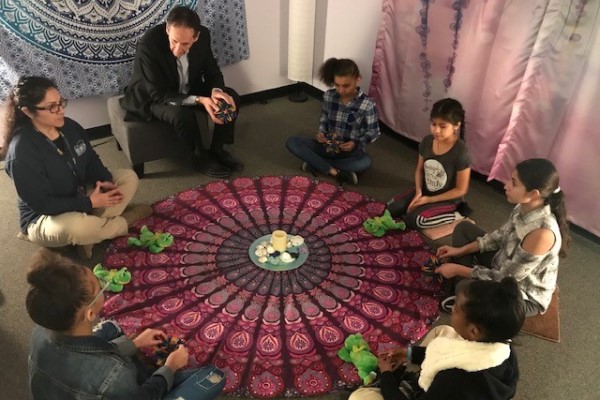Trauma-Sensitive Practices in Brockton's Schools
February 01, 2019

It’s 11:30 p.m. on a mid-September night in Brockton, Mass., when the police arrive at a 3rd-floor apartment in response to a call by neighbors. They find a woman with a facial bruise, her belligerent male companion and three school-age children. One child attempts to kick one of the officers, a second child crouches in a corner of the room wailing hysterically, and the third sits on the couch staring into a TV screen through it all.
This scenario, recently shared with me by a police officer, shows three different reactions to trauma by children from the same family — one with aggression, one with hyper-arousal and one with withdrawal.
As director of pupil support services for Brockton Public Schools, a district of 17,000 students about 25 miles south of Boston, I knew many children in our community faced difficult lives. But until about a decade ago, I believed trauma affected only a handful of students.
Awareness Training
In 2007, my perception changed significantly. I read Helping Traumatized Students Learn, a book by former teacher Susan Cole, now director of the Trauma and Learning Policy Initiative in Boston. Her insights spurred my efforts to make Brockton Public Schools more trauma-sensitive. To this day, four principles guide our work in the school district: (1) an awareness of the prevalence and effects of trauma; (2) an understanding that social-emotional well-being promotes effective learning; (3) a proactive approach to supportive relationships; and (4) explicit instruction and practice of behavioral competencies.
Our professional development trainings often result in an “aha” moment as teachers realize that behaviors appearing as willful defiance or inattention actually could be manifestations of trauma. We also conduct a series of courses with Lesley University to deepen understanding of the effects of trauma on learning and to develop a school’s repertoire of supports.
But leading change in education is essentially an act of persuasion. The following three R’s capture much of the essence of developing a trauma-sensitive school.
Reframe perspective. Our first step was to precipitate a “change of heart.” Simply mandating different behavior might elicit compliance over the short term, but our belief is that change efforts don’t succeed over the long term unless they are grounded in the culture of the school.
As educators, the way we act and react has much to do with our core beliefs about children and learning. Seeing students in a different light helps us to react more adaptively. Going from “What’s wrong with this child?” to a more a strengths-based approach, such as “What are the ‘lived experiences’ of this child?” gives us a better understanding of how to interact more successfully.
Remember, relationships matter. Our school district focuses on strengthening relationships with students. Because traumatized children essentially see the world as an unsafe place, they often have trust issues and difficulty sustaining positive relationships with adults. Such children benefit from an environment that provides emotional safety.
Routines and rituals help to increase children’s sense of attachment and security and ease their difficulty in dealing with transitions. Greeting students personally as they arrive and creating emotionally safe places such as a “calm corner” in each classroom or a “reflection room” where children can participate in mindfulness and sensory activities help improve attachment and self-regulation skills.
Peer relationships also are a source of difficulty for many children. Thus, educators must explicitly teach social skills and provide children with opportunities to practice them. Given that trauma often compromises language abilities, children benefit from “scripts” to follow and ample opportunity to practice language. We see the development of social-emotional competencies to be as essential as the development of academic competencies — and in many respects a prerequisite for them.
Other practices such as restorative discipline have been incorporated in several of our schools. These help children reflect on the implications of their actions and practice ways to make things right.
Refine practices. We’ve established school-based leadership teams in each school to pilot initiatives, report results and provide staff support. Of course, the leadership of the principal is essential, but empowering teacher leaders does much to foster staff buy-in and ensure fidelity of implementation.
Our district views trauma-sensitive schools as a work in continuous progress. This initiative is now identified as a priority in the superintendent’s strategic plan. We also have strengthened relationships with community child-welfare agencies, after-school pro-grams and counseling agencies with the intention of developing a trauma-sensitive community.
About the Author
Sal Terrasi is executive director of special projects in Brockton Public Schools in Brockton, Mass., and director of the Lesley University Institute for Trauma Sensitivity.
Advertisement
Advertisement
Advertisement
Advertisement



